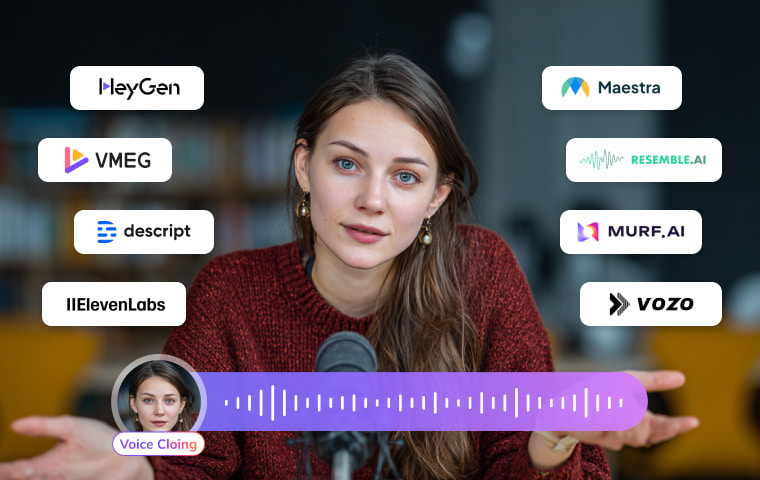
The idea of cloning a voice with AI might sound futuristic, but for many people, it’s already a practical tool in everyday life. On Reddit, one user shared a very moving story:
“I read books to my friend with a disability. I’m going to have surgery soon and won’t be able to speak much for a few months. I’d like to clone my voice first so I can record audiobooks for him.”
This is just one example of how voice cloning can make a real difference. It’s not only about creating lifelike narrations or fancy tech demos—it can also help someone keep reading to a friend, make communication easier during recovery, or simply preserve a unique voice for personal reasons.
Beyond personal stories like this, AI voice cloning is now being used in many areas: creators dub videos into different languages, teachers make learning more accessible, podcasters save time editing, gamers bring characters to life, and advertisers create engaging voiceovers.
In this guide, we’ll look at some of the best AI voice cloning tools in 2025, compare their features, and even walk through how you can use one of them—VMEG—to dub content into multiple languages.
Why AI Voice Cloning Matters
AI voice cloning is not just about copying a voice — it’s about scalability, personalization, and inclusivity. Here are the main areas where it has an impact:
- Video Localization
For businesses targeting international audiences, AI voice cloning enables fast and accurate dubbing. Instead of relying on expensive human voice actors for each language, AI can generate natural-sounding speech across 170+ languages, making global expansion faster and more affordable.
- Cross-Language Dubbing
Content creators can maintain consistency in tone and personality while making content available in multiple languages. Imagine a YouTuber reaching fans worldwide without losing their signature style.
- Accessibility
Voice cloning can support visually impaired users by producing lifelike narrations. It can also enhance accessibility in education and corporate training.
- Podcasts and Audiobooks
Podcasters can instantly generate episodes in different languages, while authors can turn books into audiobooks using their own voice without hours in the studio.
- Gaming
Game developers can bring characters to life with unique voices — or even let players use their own cloned voices in immersive environments.
- Commercials and Marketing
Brands can create consistent voice identities across commercials, explainer videos, and digital assistants. AI-generated voices make campaigns faster to deploy and easier to test.
Now that we’ve looked at why AI voice cloning is becoming so valuable across different fields—from accessibility and education to content creation and entertainment—it’s time to explore the tools that make it possible. The market is full of options, each with unique strengths, limitations, and pricing models. To help you find the right fit, here’s a breakdown of some of the best AI voice cloning tools available today.
8 Best Voice Cloning Tools
1. VMEG AI
VMEG AI is one of the most advanced tools for global voice cloning and video dubbing. It’s designed to help creators translate and dub videos into over 170 languages, with 7,000+ lifelike voices and support for emotional tone. Unlike many competitors, it specializes in professional-grade localization, making it a favorite for businesses, YouTubers, and educators.
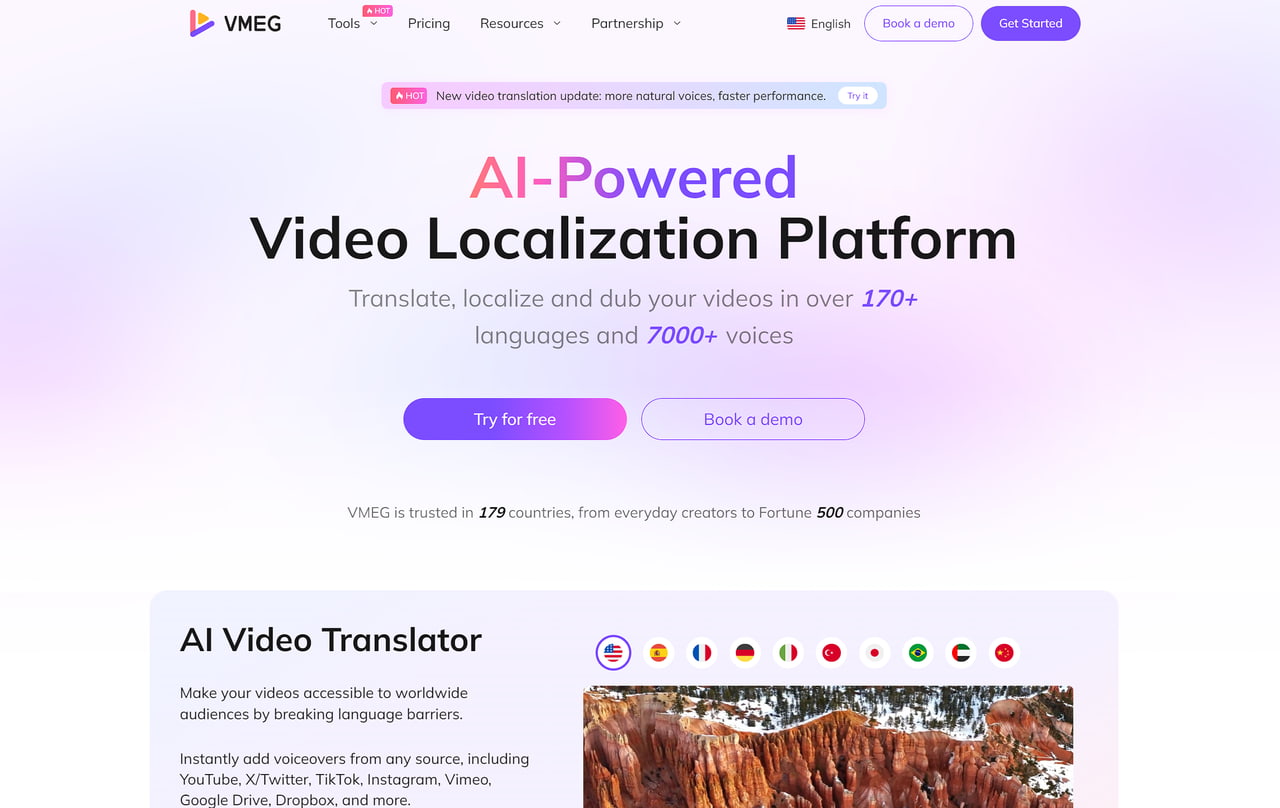
Key Features:
- 170+ languages, 7,000+ AI voices: Translate, dub, or narrate any video or audio in seconds.
- Unlimited voice cloning: One click creates a perfect replica that keeps every nuance of tone and emotion, ready to speak any language.
- Post-process lip-sync: After translation, automatically align facial movements to the new audio so every word looks naturally delivered.
- Subtitle translator & editor: Generate, translate, and style captions—font, color, position—then export in SRT, VTT, TXT, or burn-in.
- Transcription hub: Paste a URL or drop a file; get editable text in multiple formats, ready for further translation or reuse.
- Integrates video + audio dubbing in one workflow: Import your clip and let the engine handle voice replacement, lip-sync, and mixing—all in a single pass.
Pros:
- Wide global language coverage.
- Natural-sounding voices with emotion.
- Great for video + audio localization together.
- Easy to navigate, making it accessible for users of all technical levels.
Cons:
- Not offline; requires an internet connection.
Best For:
Creators and companies that need professional-grade multilingual dubbing at scale.
2. ElevenLabs
ElevenLabs is widely recognized for creating some of the most realistic AI voices available today. It’s particularly popular among podcasters, audiobook creators, and indie game developers. The platform offers near real-time voice generation with excellent fidelity.
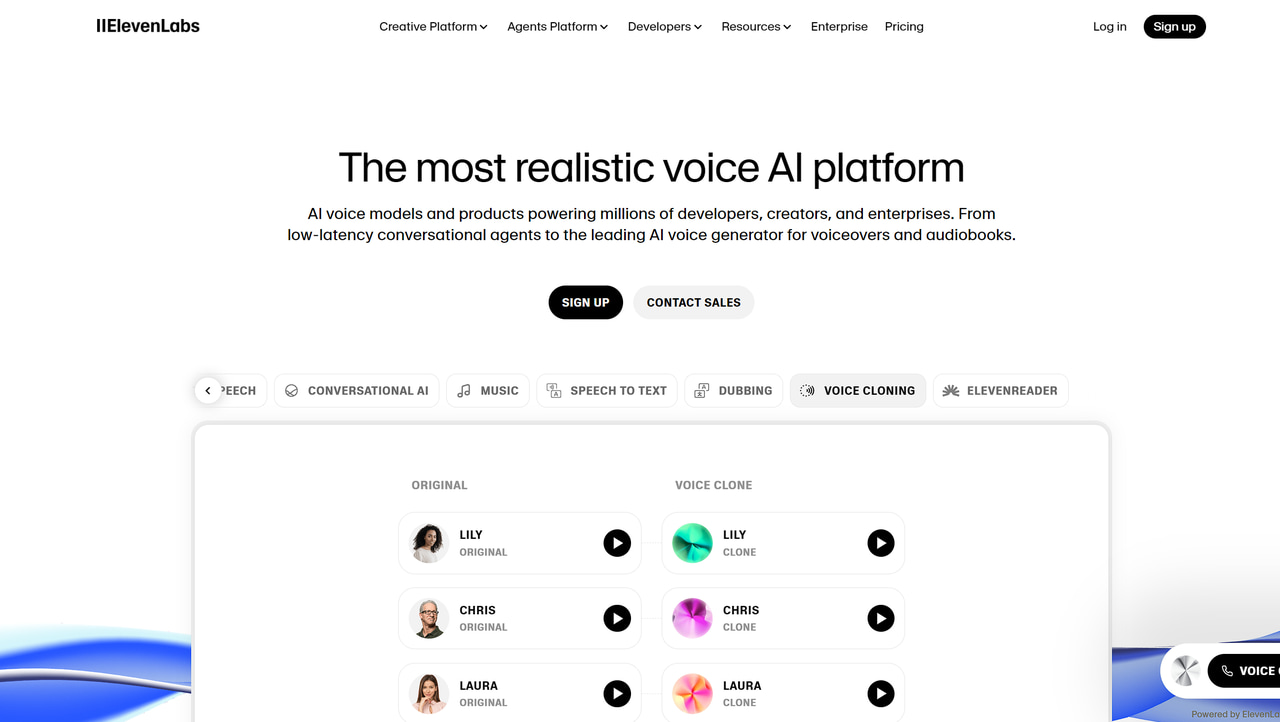
Key Features:
- Extremely lifelike voice synthesis.
- Real-time or low-latency voice generation.
- Flexible text-to-speech and voice cloning.
- Strong API for developer integrations.
- Supports multiple languages.
Pros:
- Industry-leading realism.
- Fast performance for streaming/real-time apps.
- Growing community and integrations.
Cons:
- The free plan has limits on characters.
- An internet connection is required.
Best For:
Creators who need hyper-realistic voices for audiobooks, games, or media projects.
3. Descript Overdub
Descript is much more than a simple voice cloning tool — it’s a complete multimedia editor that combines audio, video, and text-based editing in one platform. Its Overdub feature allows you to create a digital version of your own voice by training the AI on a few minutes of your recordings. Once your voice is cloned, you can seamlessly integrate it into podcasts, videos, or other audio projects.
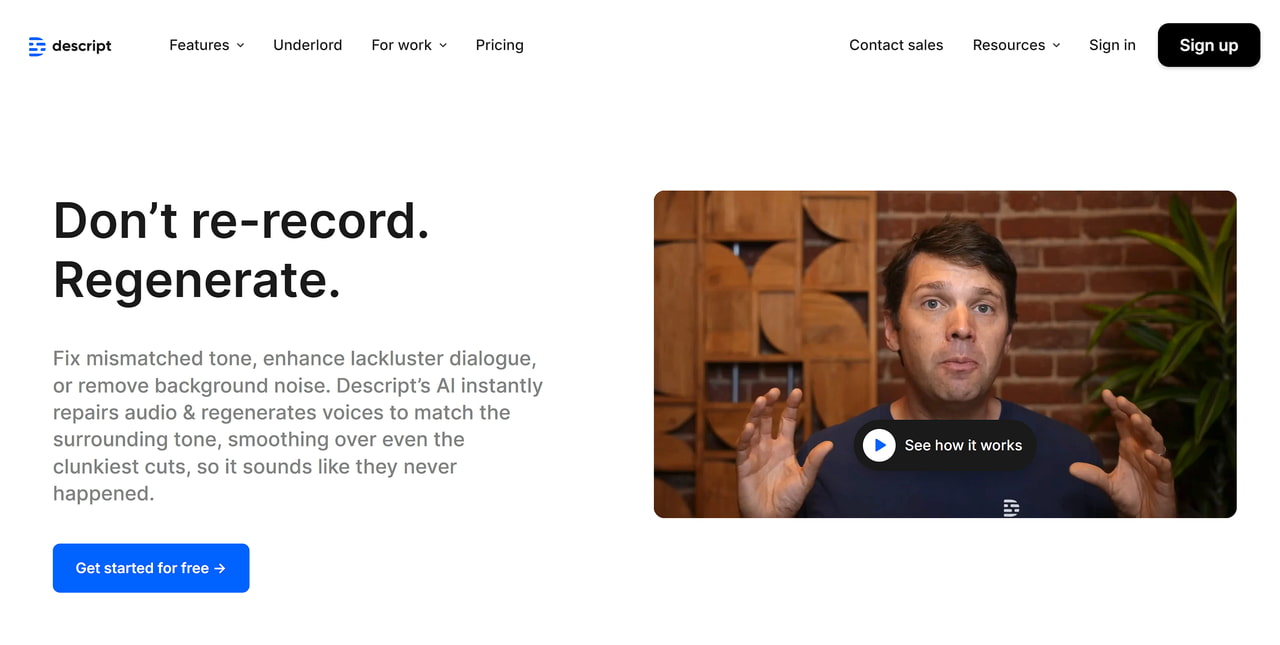
Key Features:
- Generate a realistic digital version of your voice with just a few minutes of sample audio.
- Edit your audio by simply modifying the transcript; Overdub can fill in missing words or fix mistakes without re-recording.
- Works for both audio and video projects, making it ideal for podcasters and content creators.
- Team members can work together on projects, leave comments, and track changes.
- Export your projects in multiple formats, including MP3, WAV, or video with synced audio.
Pros:
- Combines editing + voice cloning in one.
- Great for podcast and video creators.
- Easy text-based editing saves time.
Cons:
- Not ideal if you only want voice cloning.
- Requires training data to set up a custom voice.
Best For:
Podcasters, YouTubers, and content creators who want editing + cloning in one workspace.
4. Murf AI
Murf AI is designed for teams and professionals who need polished voiceovers for training, marketing, or presentations. It offers a large catalog of voices and quick editing features that make it easy to produce high-quality narrations.
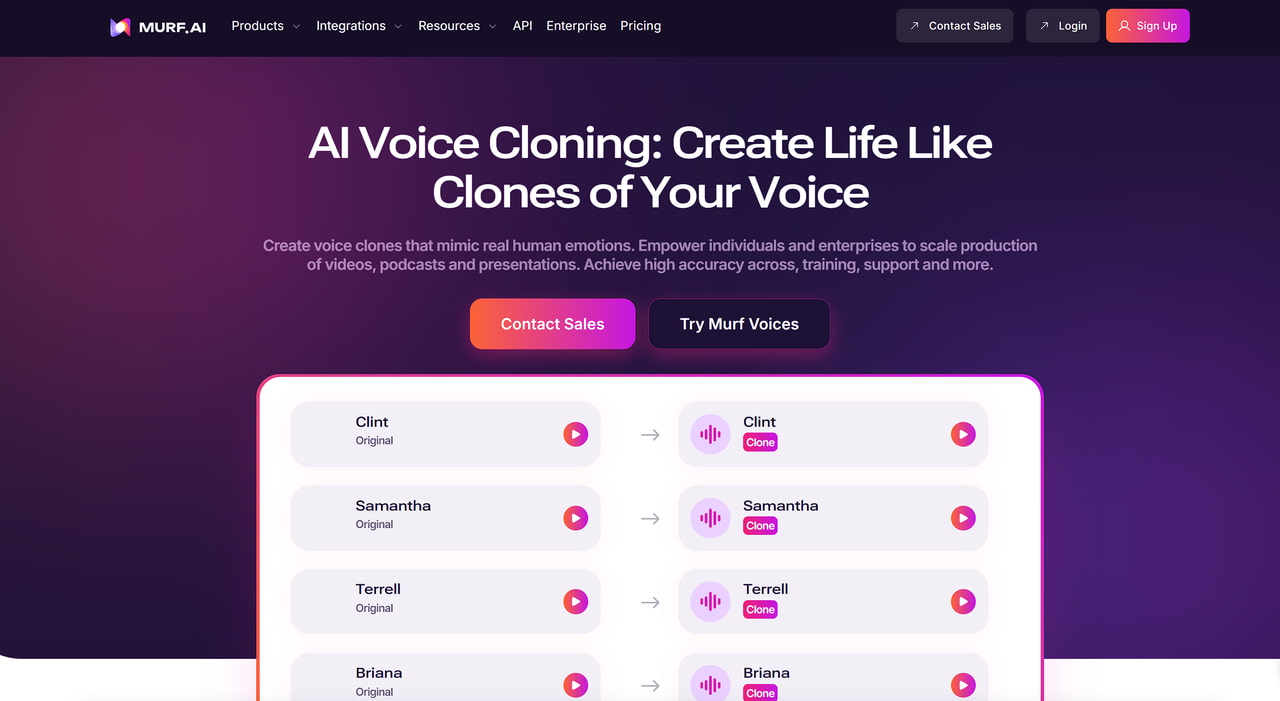
Key Features:
- 120+ realistic voices across 20+ languages.
- Voice customization with pitch, tone, and emphasis.
- Pre-built templates for quick production.
- Team collaboration tools.
- Export options for video + audio projects.
Pros:
- Easy to use with templates.
- Good range of professional voices.
- Great for corporate and e-learning use.
Cons:
- More suited for voiceover than personal cloning.
- Subscription can be pricey for individuals.
Best For:
Marketers, educators, and businesses needing professional voiceovers quickly.
5. Resemble AI
Resemble AI is a professional-grade voice cloning platform designed for businesses, developers, and content creators who need secure and scalable solutions. One of its standout features is real-time voice conversion, allowing you to speak and have your voice instantly transformed into a cloned voice. This makes it ideal for interactive applications, customer service, and dynamic content creation.

Key Features:
- Speak naturally, and the AI generates the cloned voice immediately.
- Create unique AI voices from short audio samples.
- Supports private deployments and strict data controls, suitable for enterprise use.
- Add tone and emotion to make voices sound more natural.
- Developers can integrate Resemble AI into apps, games, or workflow pipelines.
Pros:
- Enterprise-ready with security features.
- Real-time conversion sets it apart.
- Supports emotional tones.
Cons:
- More expensive than casual tools.
- Setup complexity for beginners.
Best For:
Enterprises, game developers, and advanced users need real-time voice cloning.
6. Maestra AI
Maestra AI focuses on helping YouTubers and businesses localize videos with dubbing, captions, and subtitles. It has an intuitive workflow that makes it easy for beginners to translate and voiceover content.
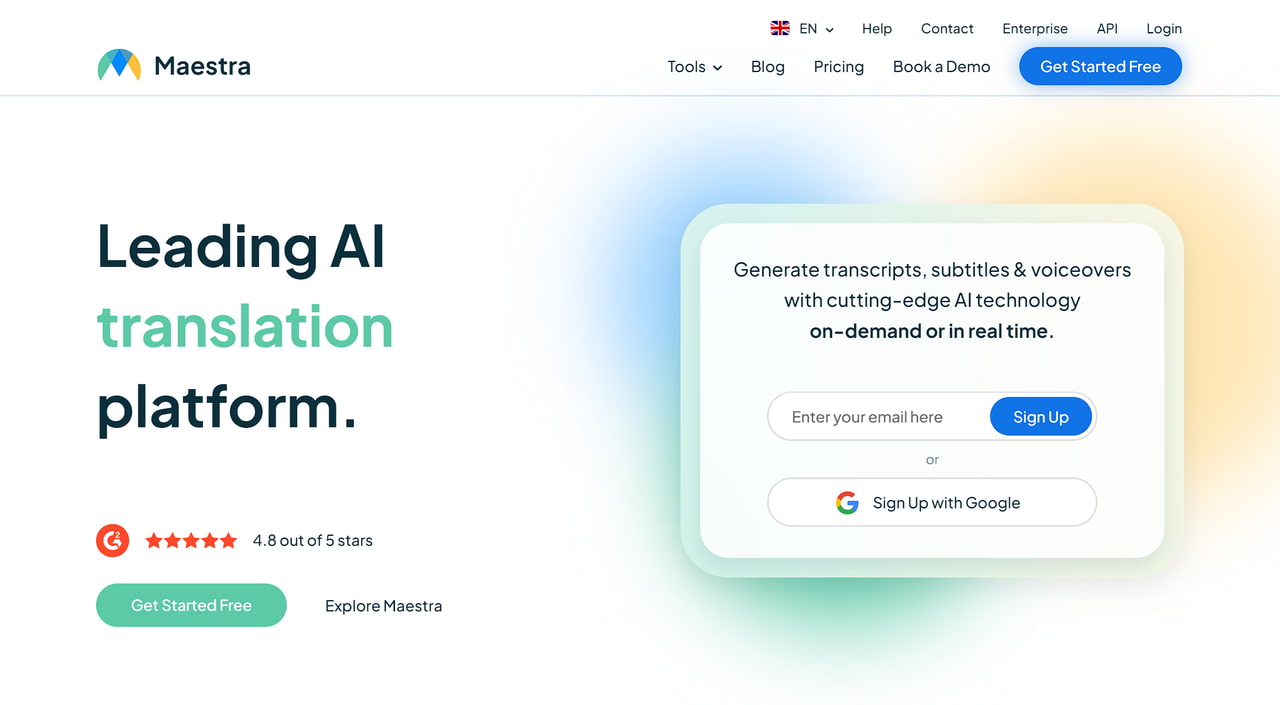
Key Features:
- Auto-translation into 80+ languages.
- AI-generated dubbing + subtitles.
- Built-in YouTube + workflow integrations.
- Collaboration for teams.
- Text-to-speech with different voices.
Pros:
- Great YouTube integration.
- Easy workflow for non-technical users.
- Combines subtitles + dubbing.
Cons:
- Limited emotional expressiveness in voices.
- Less control for professional audio engineers.
Best For:
YouTubers, educators, and businesses who need easy multilingual dubbing.
7. HeyGen
HeyGen is an AI platform that combines voice cloning with video avatars, making it ideal for marketers, sales teams, and content creators who want to produce engaging videos quickly. With HeyGen, you can generate a talking avatar that speaks in a cloned voice, producing professional-looking videos without the need for actors or recording studios.
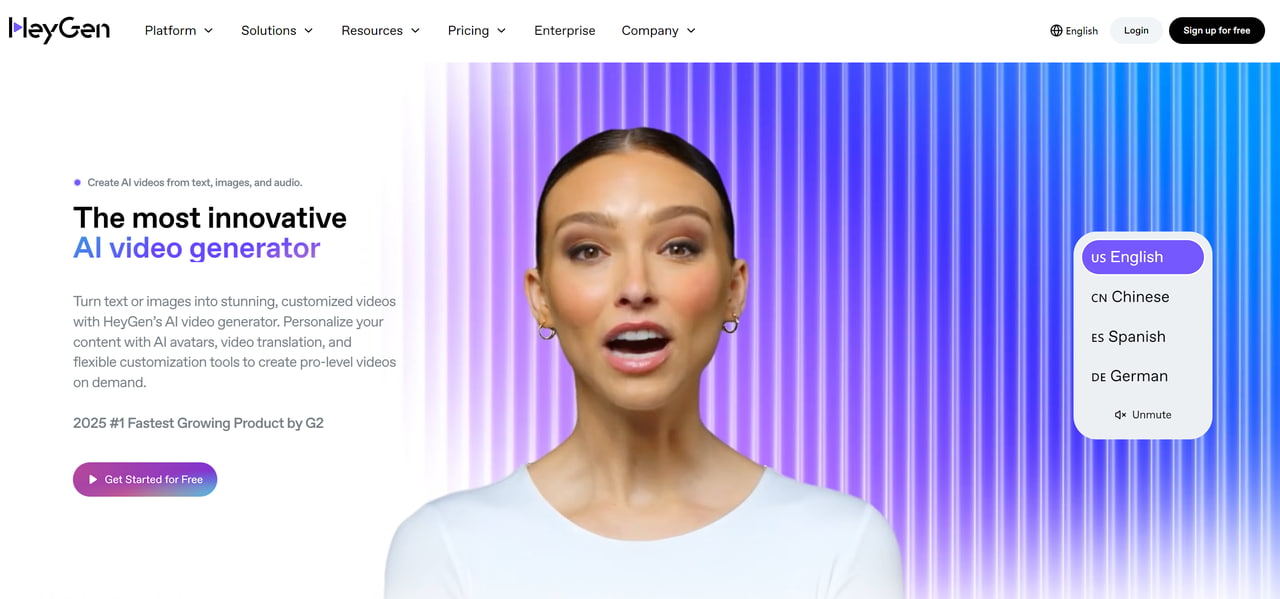
Key Features:
- Bring your scripts to life with a talking digital character.
- Reach global audiences with localized content.
- Create characters that reflect your brand identity.
- Turn text scripts directly into fully voiced video content.
- Prebuilt templates make video creation fast and easy.
Pros:
- Combines voice + video in one platform.
- Easy for marketing teams.
- Quick production with templates.
Cons:
- Limited use outside marketing.
- Less focus on pure voice quality compared to ElevenLabs or VMEG.
Best For:
Marketers, sales teams, and startups creating explainer videos with voice + avatars.
8. Vozo AI
Vozo AI specializes in voice cloning with minimal input. Unlike some platforms that require hours of training data, Vozo can generate a cloned voice from short samples, making it ideal for quick turnaround projects.
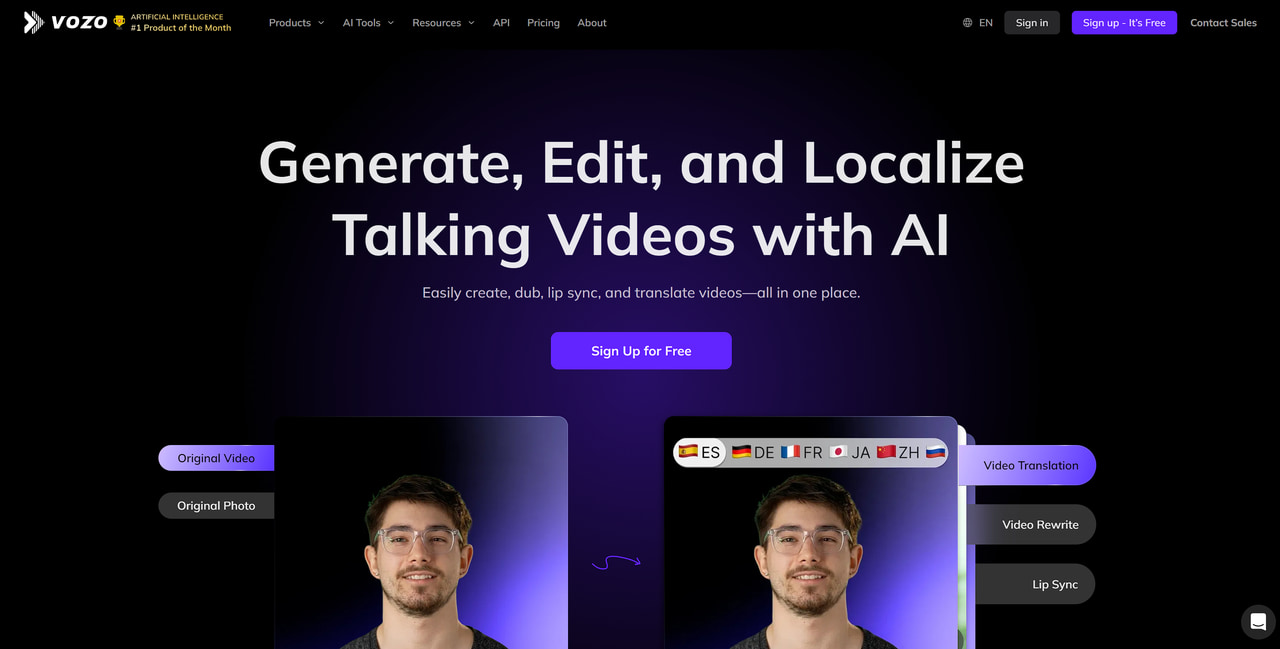
Key Features:
- Short-sample voice cloning.
- Video localization toolkit included.
- Multilingual support.
- Simple workflow for fast dubbing.
- Integration with content platforms.
Pros:
- Quick and efficient cloning.
- Great for video translation/localization.
- Minimal training required.
Cons:
- Less advanced customization.
- Limited free tier.
Best For: Content creators who want fast, simple cloning for video projects.
Comparison Table of Top AI Voice Cloning Tools
| Tool | Best For | Languages | Custom Voices | Real-Time | Video Support | Ease of Use |
| VMEG | Video localization, dubbing | 170+ | Yes | No | Yes | High |
| ElevenLabs | Media & publishing | 29+ | Yes | Yes | Limited | Medium |
| Descript | Podcasters, video editing | English | Yes | No | Editing focus | High |
| Murf AI | Marketing, training videos | 20+ | No | No | Yes | High |
| Resemble AI | Enterprise, real-time cloning | 60+ | Yes | Yes | Limited | Medium |
| Maestra AI | YouTube & workflow integration | 80+ | No | No | Yes | High |
| HeyGen | Marketing content & avatars | 30+ | No | No | Yes | High |
| Vozo AI | Short-sample localization | 50+ | Yes | No | Yes | Medium |
Step-by-Step Guide: How to Voice Clone with VMEG
Now that you’ve seen how these tools stack up in the comparison table, you might be wondering, “Okay, but how do I actually use one?” Let’s walk through a simple, hands-on example with VMEG, so you can see exactly how easy it is to clone a voice step by step.
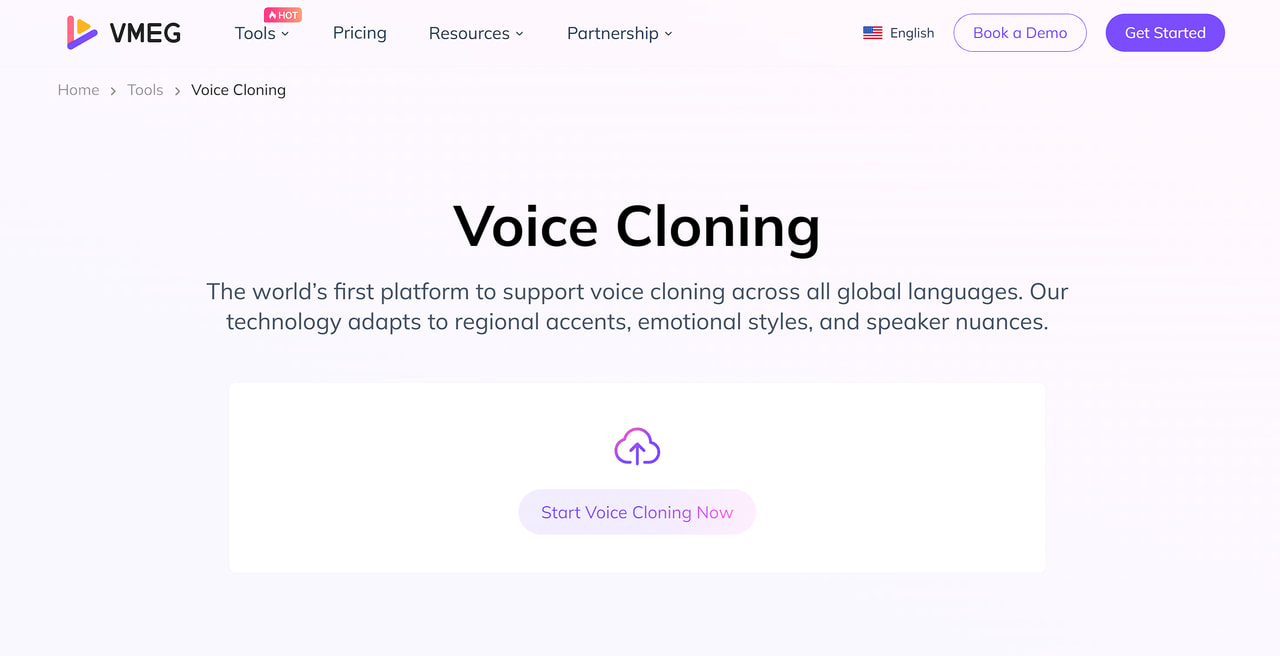
Step 1. Upload Your Voice Sample File
Click on “Add Voice Clone” and upload a short audio file (MP3 or WAV, under 20MB and at least 3 seconds long).
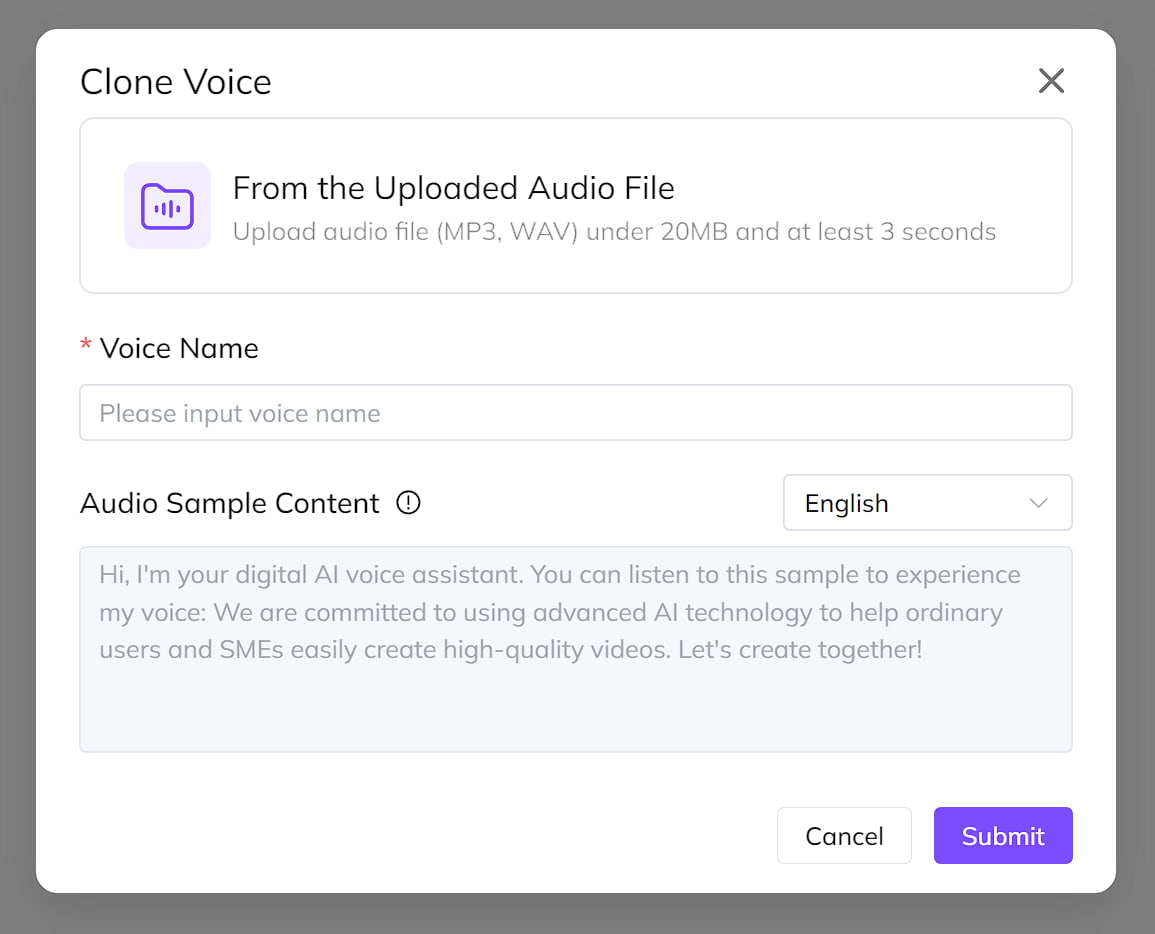
Step 2. Generate Your Cloned Voice
Give your voice a name and click “Submit.” VMEG will process your audio and create a cloned voice. Once it’s ready, you can preview it to make sure it sounds right.
Step 3. Use Your Cloned Voice
Now you can apply your new voice wherever you need it. The cloned voice can be used in the following ways:
- Directly in VMEG’s Text-to-Speech feature to generate speech from any text.
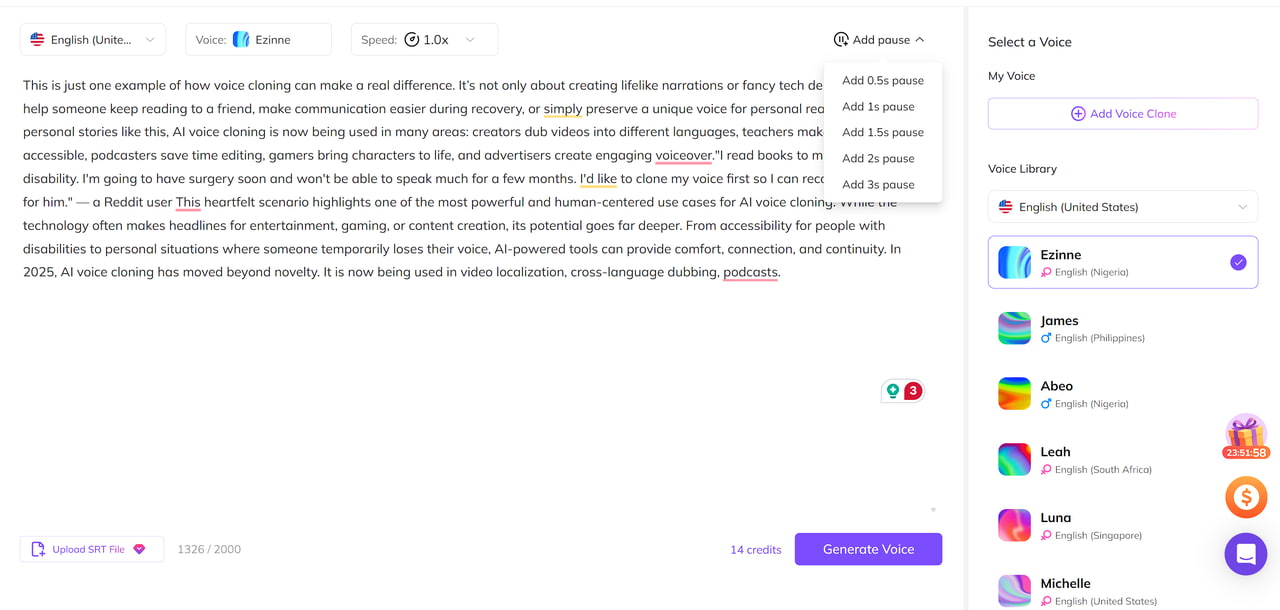
- In audio and video translation as the translated voice.
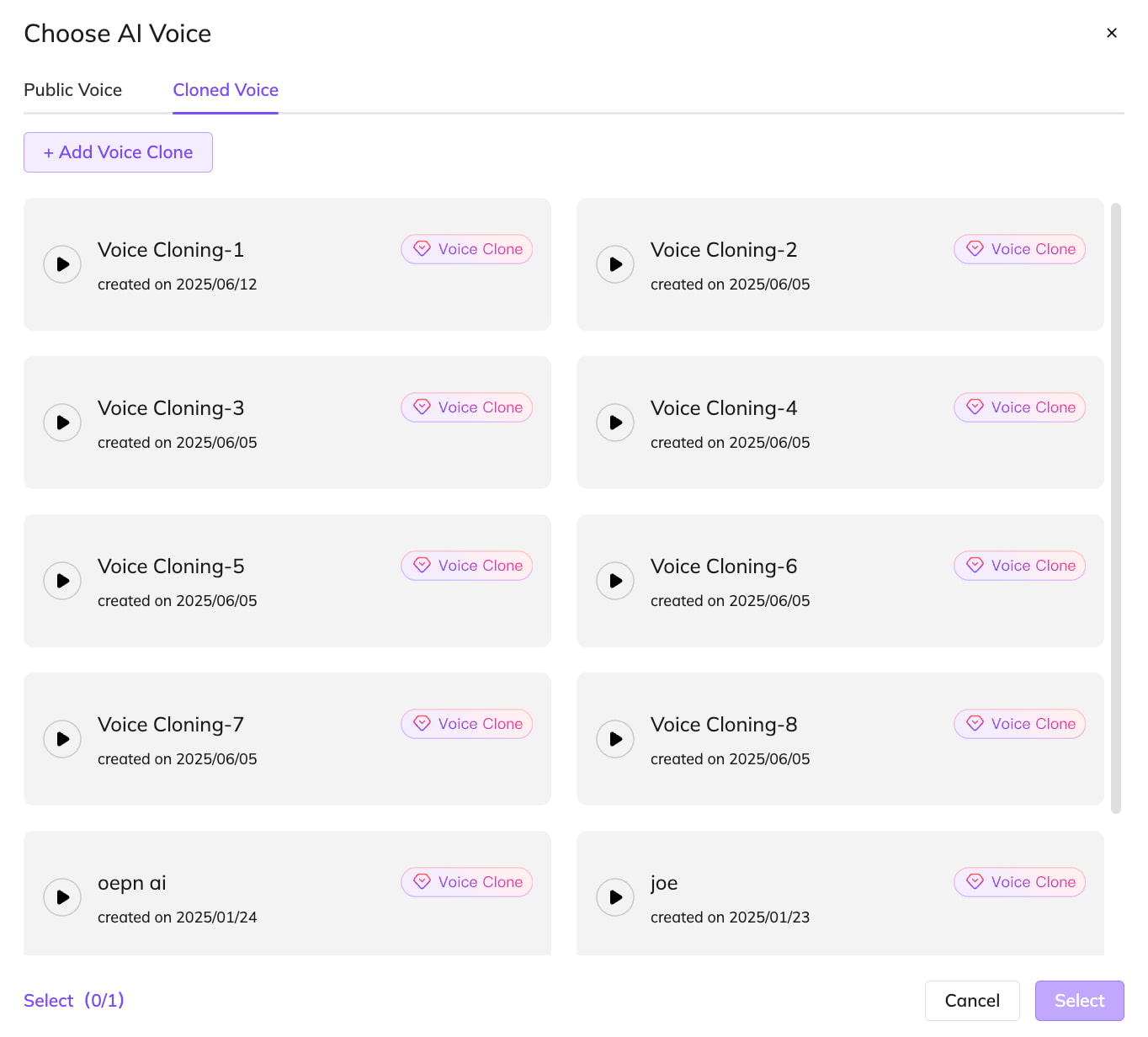
Principles We Follow When Testing Voice Cloning Tools
| Principle | What It Means | Why It Matters |
| Naturalness | Does the voice sound like a real person instead of a robot? | A natural voice keeps listeners engaged and feels more trustworthy. |
| Prosody | Are tone, rhythm, and pauses natural? | Good flow makes the speech easier to follow and less tiring. |
| Timbre Similarity (for cloning) | Does it really capture the speaker’s unique voice? | Helps preserve identity and emotional connection. |
| Intelligibility | Can every word be clearly understood? | Clear speech avoids confusion, especially on different devices. |
| Video Sync (for dubbing) | Do lip movements match the audio timing? | Keeps dubbing realistic and less distracting. |
| Artifacts | Are there clicks, weird breaths, or noise? | Fewer glitches mean smoother, more professional output. |
FAQs of AI Voice Cloning
Is AI voice cloning legal?
Yes, as long as you own the rights to the voice or have permission from the speaker.
Can I use AI voice cloning for commercial projects?
Most platforms allow commercial use, but terms may vary by provider.
Which AI voice cloning tool is best for YouTube creators?
Maestra.ai and VMEG are strong options thanks to their video integration and multilingual dubbing.
How realistic are AI-cloned voices?
The latest AI voices are nearly indistinguishable from human recordings, especially with tools like ElevenLabs and VMEG.
Does AI voice cloning replace human voice actors?
Not entirely. Human actors are still preferred for high-budget creative projects, but AI is ideal for scaling content quickly.
How much audio do I need for a convincing clone?
It varies: some platforms advertise instant cloning from 30s–1min for a usable clone, while “professional” or higher-fidelity clones often require tens of minutes or a dedicated recording session. Check vendor docs: Resemble lists short test options and ElevenLabs documents instant vs professional cloning modes.
Conclusion
AI voice cloning is transforming the way we create and share content. From localization and accessibility to marketing and gaming, these tools make it possible to communicate across languages and platforms faster than ever before.
Among the many solutions available, VMEG stands out for its ability to deliver professional-quality dubbing across more than 170 languages with a vast library of natural voices. Whether you’re a creator, business, or educator, VMEG offers a reliable way to scale your content globally.
If you’re ready to reach a wider audience and cut production costs, now is the time to explore the possibilities of AI voice cloning.
VMEG Voice Cloning
Unlock the Power of Voice Cloning in Every Language with VMEG! Experience the World's First Global Voice Cloning Platform Today.
